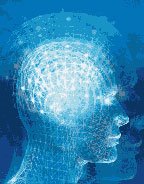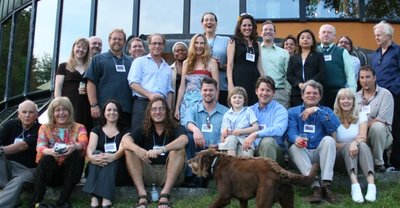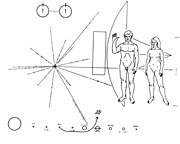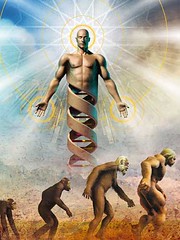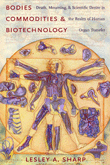
Despite grandiose and cocksure proclamations to the contrary,
consciousness is still a hard problem in science. Aside from (currently) untestable theories and philosophical musings, how matter organizes itself such that it is capable of experiencing
subjectivity and
qualia is an utter mystery.
Compounding the problem is the widespread tendency to interchangbily use the terms intelligence and consciousness. While related, these terms describe two very different phenomena. My calculator and computer are examples of intelligence. My ability to use language and deductive reasoning to help me write this article are other examples of intelligence. But my ability to subjectively experience the phenomenon known as 'sweetness,' or to sense the colour red, or the feeling I get as time passes, are endowments brought about by my conscious awareness.
There are arguably two major philosophical approaches to the issue of consciousness -- they are 'philosophical' because we still don't possess the requisite scientific vernacular to address its true underpinnings. These proto-scientific approaches are known as dualism and emergence.
The first and most traditional argument is the idea of
vitalism or
dualism. This perspective suggests that the essence of consciousness lies outside the brain, perhaps as some ethereal soul or spirit. Consequently, its proponents suggest that consciousness lies outside knowable science.
Cartesian dualism fits within this category of thinking – the notion that the only thing that can truly be known is the presence of personal subjectivity and that everything external to that may be a fabrication or hallucination (see Descarte’s
Meditations on First Philosophy and his ‘
Evil Daemon’ argument). While existentially interesting (or is that disturbing?),
Descartes’s argument violates
Popperian notions of testability and smacks of
Gnosticism and radical
skepticism (these are fascinating topics in their own right that lie outside the scope of this discussion, and can include such conundrums as the
brain-in-the-vat and
simulation problems).
The other broad approach to the issue of consciousness is
emergence theory, the idea that self-awareness and qualia can arise from complex computational dynamics in the brain. The critical assumption here is that mind’s architecture is largely computational, but that consciousness emerges through the concert of myriad neuronal interactions. In this sense, consciousness is an epiphenomenon or metaphenomenon of the brain's machinations.
This approach to cognition is clearly essential, but it is not sufficient. Indeed, the mind almost certainly utilizes its computational or
functionalist aspects, most of which go completely unnoticed by the conscious agent at the top of the processing hierarchy. Today’s computers, which have inspired comparisons to the brain, crunch numbers but are in no way self-reflexive about their work; consequently, they can partly account for human
intelligence, but make relatively poor models as approximations or metaphors for consciousness engines.
At the same time, it almost seems like a cop-out to suggest that increased complexity in such systems will result in consciousness, which is, qualitatively speaking, a horse of a different colour.
Now, I wouldn’t want to dismiss emergence theory outright. There’s something very satisfying about this idea, particularly considering how this might have come about through natural selection. It may very well turn out that that emergence does in fact account for consciousness.
That said about dualism and emergence, there is a third, albeit controversial, perspective that should be considered:
panprotopsychism. This is the notion that essential features or precursors of consciousness are fundamental components of reality which are accessed by brain processes. In philosophy,
panpsychism is the view that all parts of matter involve mind. Neuroscientist
Stuart Hameroff, a proponent of this view, argues that consciousness is related to a fundamental, irreducible component of physical reality, akin to phenomenon like mass, spin or charge. According to this view, the basis of consciousness can be found in an additional fundamental force of nature not unlike gravity or electromagnetism. This would be something like an elementary (self)-sentience or awareness. As Hameroff notes, "these components just are."
Panpsychism has a long a varied history. Back during the time of the Greeks, philosophers like
Democritus contended that a basic and fundamental form of consciousness was a quality of all matter – what they called '
atomism.' Later,
Baruch Spinoza would argue along similar lines -- that atoms and their subatomic components have subjective, mental attributes.

Relatedly, Buddhist atomists like
Dharmakirti argued that the only thing that exists are
Buddhist atoms (described as being point-sized, durationless, and made of energy) and states of consciousness. Similarly,
Gottfried Leibniz and
A. N. Whitehead believed that systems ordinarily considered to be physical were constructed in some sense from more basic mental entities – what are now referred to in
process philosophy as 'Whitehead occasions.'
Bertrand Russell put forth the idea of "
neutral monism," which described a common underlying entity, neither physical nor mental, that gave rise to both.
Bishop Berkeley suggested that consciousness creates reality and that consciousness is "all there is." Berkeley's famous dictum was "Esse est percipi" ("To be is to be perceived").
Theoretical physicist
John A. Wheeler has suggested that information is fundamental to the physics of the universe, and
David Chalmers has proposed a
double-aspect theory in which information has both physical and experiential aspects.
While these ideas vary, they do explore the interplay between what is regarded as reality and consciousness. Whitehead in particular saw the universe not as being comprised of 'things' but of 'events.' In this sense reality is a kind of process where consciousness emerges from temporal chains of occasions.
If this sounds somewhat analogous to what quantum mechanics tells us, you’re not far off the mark. A number of thinkers have picked up on Whitehead’s idea as it relates to quantum physics, including
Abner Shimony and
Roger Penrose. This has lead to the development of what is known as
quantum consciousness theory, which postulates the idea that consciousness is indelibly tied to quantum processes – that the brain is essentially a quantum computer utilized by an observer to “decohere” quantum superposition. Penrose and
Stuart Hameroff have constructed a theory in which human consciousness is the result of quantum gravity effects in
microtubules.
Penrose’s ideas have been met with much scorn, not least of which for his assertion that there are non-computational or non-algorithmic aspects to consciousness. This suggestion has lead thinkers like Hameroff and Penrose to conclude that mature AI as it is typically presumed (i.e. that it is also endowed with
artificial consciousness) is a pipe-dream.
If they’re right, however, this poses a significant problem for those who believe that uploading (or
mind transfer) awaits humanity in the future -- the opinion that consciousness is not substrate dependant, and that a fully sapient agent can exist as an uploaded being in a supercomputer. Many transhumanist expectations, from radical
life extension to
Jupiter Brains, are dependant on this assumption.
But what if consciousness is in fact substrate specific and can only be experienced in the analog arena? What if there is no digital or algorithmic equivalent to consciousness like Penrose suggests? Having consciousness arise in a classical
Von Neumann architecture may be as impossible as splitting the atom in a virtual environment by using ones and zeros.
As possible consolation, however, the fact of the matter is that under the Penrose/Hameroff premise, the brain is a
quantum computer – which if quantum theorists like
David Deutsch have their way, will eventually come to fruition. If a quantum computer comprised of biological matter could arise through autonomous evolutionary processes, then I would have to think that intelligences like our own will eventually come to figure it out. If this is the case, then it may be possible to engineer subjectivity outside of our grey matter. Quantum computers could also be useful for running simulations of quantum mechanics, an idea that goes back to
Richard Feynman; he observed that there is no known algorithm for simulating quantum systems on a classical computer and suggested to study the use of a quantum computer for this purpose. One has to wonder if the same logic applies to the potential for quantum computers to run consciousness simulations.
Given the extreme computational power and speed of quantum computers, I can’t even become to fathom what a conscious agent would do within such an architecture.
All bets are off once a conscious superintelligence starts to engage in selective decoherence.
References:
Stuart Hameroff: "
Consciousness, Whitehead and quantum computation in the brain: Panprotopsychism meets the physics of fundamental spacetime geometry"
John Holbo: "
Fragments of Parallax"
WikipediaRelated
Sentient Developments reading:
"
Working the Conscious Canvas"
"
Many Mangled Worlds?"
"
Blindsight and our unconscious life"
"
Dalai Lama 'craving a discourse'"
 Sci-Fi author Simon Funk has released an excellent short story that he has made available for free over the Internet. The story is called "After Life" and deals with the issue of consciousness uploads.
Sci-Fi author Simon Funk has released an excellent short story that he has made available for free over the Internet. The story is called "After Life" and deals with the issue of consciousness uploads.
